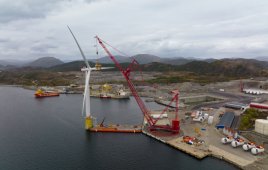The New Jersey Wind Port, currently under construction, is slated to be the nation’s first purpose-built offshore wind marshalling and manufacturing port, an important milestone for offshore wind development in the United States. The port broke ground in 2021, and its first phase is on track for completion in April 2024. Subsequent phases will be completed between 2025 and 2028. Sam Schacht of the Clean Energy States Alliance (CESA) sat down with Jon Kennedy, VP of infrastructure at the New Jersey Economic Development Authority (NJEDA), to talk about how progress is coming along and why the port is so important for the future of offshore wind. Their conversation was shared with Windpower Engineering and Development.
Sam: This was an incredibly ambitious public project. What went into NJEDA’s decision to go ahead with it?
John: As with any major infrastructure investment, there needs to be a very thorough preliminary process to interrogate both the economics and the technical aspects of the project. We spent approximately 18 months to two years analyzing the market fundamentals and economics, and then we built a business case. After that we turned our attention to a shortlist of over 40 potential sites.
Ultimately, we landed on the current site, which is in Lower Alloways Creek in Salem County. We chose that site because there were fewer environmental and residential impacts. What gave us the confidence to invest was knowing that in order to get to 100% clean energy, offshore wind at scale is non-negotiable. In order to achieve that target, we are going to have to create a significant number of jobs to manufacture, move, install and maintain these components. It was a no-brainer to proceed with this project. In general, it’s risky to be a first mover. I’d argue that it’s risky not to be a first mover — it’s risky to delay. In fact, by moving quickly, we’re de-risking our energy targets and we’re increasing the potential to attract jobs and investment to New Jersey.
For a public works project, the pace that we’re moving at is unprecedented. What’s driving the pace of this project is the need for this port to be operational in time for Ocean Wind 1. We’ve made a commitment to Ørsted that the port will be ready in time for their needs, and we’re determined to honor that commitment.
And of course, if we are successful on this project, we are estimating somewhere in the region of 1,500 ongoing jobs that’s across manufacturing, operations, and related services. Many of those jobs will have to come from within the community, so that’s a real opportunity for Salem County and Southern New Jersey.
Why is the New Jersey wind port so important to the broader development of offshore wind in the United States?
There are two parts to the answer. First, this port is about safeguarding New Jersey’s ability to meet its offshore wind targets — 11 GW — on time and cost effectively. It’s well documented that the U.S. currently lacks the port capacity needed for offshore wind and New Jersey is no exception to that.
Existing container and conventional break-bulk ports are ill-equipped to accommodate the sizes, weights and space requirements for offshore wind without significant capital improvements. Every acre of space in existing container ports is soaked up meeting demand for container freight, and existing ports are focused on meeting container freight demand, so there are very few existing ports that can accommodate offshore wind alongside their existing goods. There are also very few locations on the East Coast that have the attributes to be developed into a new port. We need this port to meet not just New Jersey’s targets, but also other states’ targets, because this is very much a regional, if not a national, asset. This port will have the capacity to serve both New Jersey and other states as well, and to help those states meet their targets on time and cost effectively.
The second piece is about providing a base for the supply chain and creating jobs here in the U.S., particularly in New Jersey and the wider Delaware Valley region. When you look at European precedent, the supply chain has by necessity centered and clustered around the ports. These components are so big they can’t be moved. They can’t be moved by rail or by road; they can only be moved by vessel. So, if a factory is at the marshalling port, it’s much more efficient and cost-effective in terms of avoided double handling.
You can effectively manufacture these components and wheel them out the factory gates onto the marshalling port and onto a vessel. If you manufacture them elsewhere, then you have to handle them, load them onto a vessel, that vessel has to get them to the marshalling port, unload them, marshal them, load them back out to sea. Being able to co-locate manufacturing and marshalling can create huge efficiencies. And that’s ultimately good for rate payers, right? Because it means lower prices at the end of the day.
How have you incorporated equity into the building of the New Jersey Wind Port?
Here at EDA, we’re very focused on ensuring that we create this industry in the right way from the beginning so that we’re thinking about equity and inclusion from day one. We have an opportunity to get it right the first time. We’re very focused on ensuring that we set new bars for diversity and inclusion. This project has a goal of 15% minority, women and veteran-owned businesses, or XBE, which was always a bare minimum. It’s never the target — the target is always to exceed that percent. Today, we’re actually close to 50% XBEs by dollar value in terms of contracts awarded. We also have a small business target of 25%, and a service-disabled veteran target of 3.9%. We are determined to keep exceeding those targets on the project.
Beyond the targets we’re engaging with the community on the project, because it’s only right that the community is closely involved. We have a Diversity and Local Engagement Advisory Committee that meets bimonthly, which is one mechanism to ensure that the community knows what’s going on, can have its say on the project, can raise concerns on a regular basis, and have those concerns addressed. We had three priorities when we set up the Committee: the first was having the group in place before construction started, which helps to build that sense of involvement, participation and ownership of the project by the community. We’re able to signal ahead of time what packages of work, contracting opportunities, and job opportunities are coming, and the Committee can also promote those opportunities within the community.
The second priority is to strike a balance between meeting regularly and being cognizant of the community’s time. They all have their other jobs to do, but we find that a bimonthly meeting is beneficial, because it helps keep the committee current on the project. Third, for this committee to be effective, we need to have two-way conversations. It shouldn’t just be EDA providing an update. The community has a forum to speak to us and to share their concerns or ideas. It’s as much for us to hear from the community as it is for the community to hear from us.
Lastly, I’d add that union labor has been a keystone of New Jersey state projects, and the wind port is no different. The Wind Port project is 100% union labor. The unions will say it’s not just about giving people jobs but giving people careers. We derive significant benefits from what unions invest in their members, especially when it comes to safety and skills. We have ongoing engagement with the unions, including on things like improving diversity and inclusion, which is one of our major goals.
Filed Under: Featured





